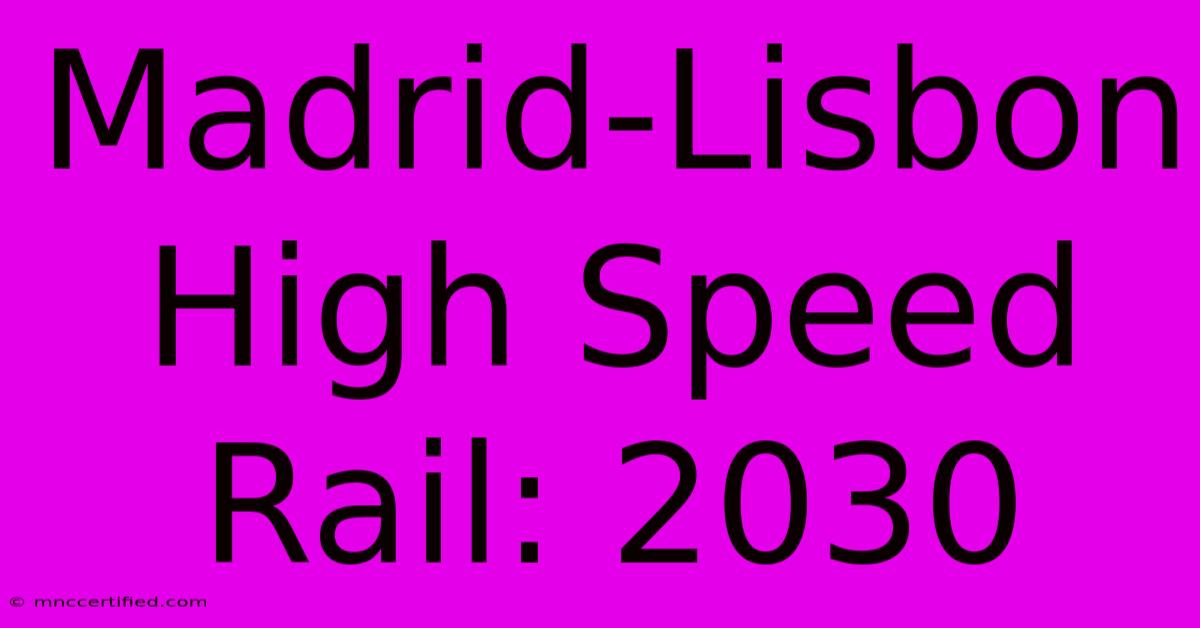Madrid-Lisbon High Speed Rail: 2030

Table of Contents
Madrid-Lisbon High-Speed Rail: Will We See It by 2030?
The dream of a high-speed rail connection between Madrid and Lisbon, two iconic Iberian Peninsula capitals, has been decades in the making. While a 2030 completion date is ambitious, significant progress is being made, fueling optimism—and raising questions. This article delves into the current state of the project, exploring its challenges, potential benefits, and the likelihood of reaching the ambitious 2030 target.
The Madrid-Lisbon High-Speed Rail Project: A Vision for Iberian Connectivity
The proposed high-speed rail line aims to drastically reduce travel time between Madrid and Lisbon, currently around 9-10 hours by conventional train. High-speed rail promises a journey time of approximately 2.5 to 3 hours, transforming regional connectivity and boosting tourism and economic development. This ambitious undertaking represents a significant step toward modernizing Iberian infrastructure and enhancing cross-border collaboration.
Key Route and Infrastructure Challenges
The route itself presents considerable geographical challenges. The terrain between the two capitals is varied, traversing mountainous regions and requiring extensive tunneling and bridge construction. Funding remains a major hurdle, with substantial investment required from both Spain and Portugal, potentially involving EU funding sources. Land acquisition and environmental impact assessments also contribute to the complexity and potential delays.
Furthermore, achieving interoperability between the Spanish and Portuguese rail systems is crucial. Different track gauges and signaling systems necessitate significant harmonization efforts, adding to the project's technical complexities. Ensuring seamless integration will be vital for the efficient and safe operation of the high-speed line.
Economic and Social Impacts: A Boost for the Iberian Peninsula
The successful completion of the Madrid-Lisbon high-speed rail link promises significant economic and social benefits for both countries:
- Tourism: Faster travel times will attract more tourists to both cities and the surrounding regions, boosting local economies and creating jobs.
- Business: Improved connectivity will facilitate business interactions, fostering trade and investment between Spain and Portugal. Commuting between major cities will become significantly easier, attracting skilled workers and promoting economic growth.
- Regional Development: The high-speed rail line is expected to stimulate economic development in smaller towns and cities along the route, reducing regional disparities.
- Reduced Carbon Footprint: Replacing car and air travel with high-speed rail contributes significantly to reducing the carbon footprint, aligning with sustainability goals.
2030 Deadline: Realistic or Optimistic?
The 2030 target for completion is undeniably ambitious. While significant progress is being made, unforeseen delays related to funding, engineering challenges, and bureaucratic processes could easily push back the completion date. Transparency and efficient project management will be key to staying on schedule and within budget.
Several factors will determine whether the 2030 deadline is met:
- Securing sufficient funding: Consistent and timely funding is paramount for the project's success.
- Effective collaboration between Spain and Portugal: Strong cooperation between the two governments is crucial for overcoming technical and logistical hurdles.
- Efficient environmental impact mitigation: Addressing environmental concerns and obtaining necessary permits in a timely manner is essential.
- Effective public communication and engagement: Keeping the public informed and addressing concerns about the project's impact is vital for building support.
Conclusion: The Future of Iberian Rail Travel
The Madrid-Lisbon high-speed rail project represents a significant infrastructure undertaking with the potential to transform Iberian connectivity. While reaching the 2030 target is challenging, the potential benefits for tourism, business, and regional development are substantial. The coming years will be crucial in determining whether this ambitious vision becomes a reality. Continued progress, transparent communication, and effective collaboration will be key to ensuring the successful completion of this landmark project. The possibility of a high-speed journey between these two captivating capitals by 2030 remains exciting, even if uncertainty lingers.

Thank you for visiting our website wich cover about Madrid-Lisbon High Speed Rail: 2030. We hope the information provided has been useful to you. Feel free to contact us if you have any questions or need further assistance. See you next time and dont miss to bookmark.
Featured Posts
-
Insurance Auto Auction Lorain Ohio
Nov 16, 2024
-
Kosovo Vs Romania Preview And Match Prediction
Nov 16, 2024
-
Daily Acca Treble On Nations League
Nov 16, 2024
-
Tmj Surgery Cost Without Insurance
Nov 16, 2024
-
Mike Tyson Vs Jake Paul Fight Where To Watch
Nov 16, 2024